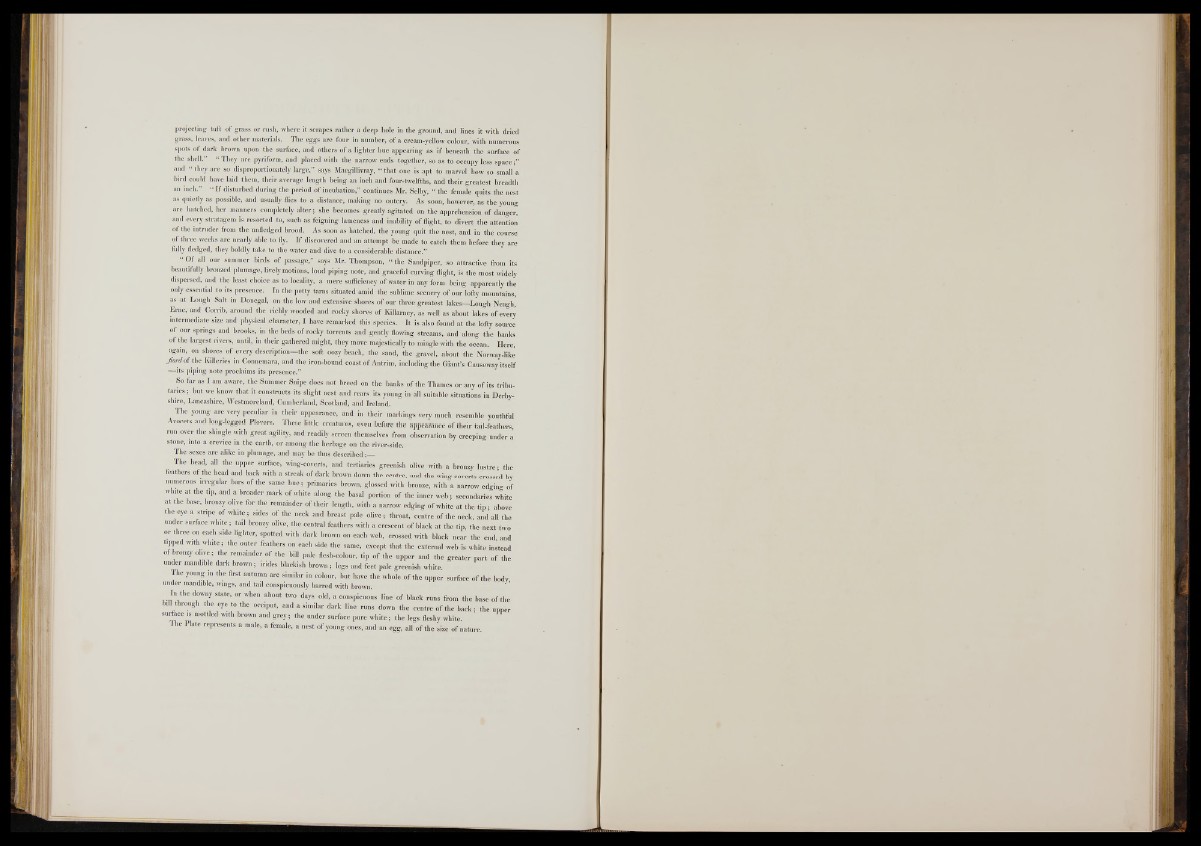
projecting tuft o f grass or rush, where it scrapes rather a deep hole in the ground, and lines it with dried
grass, leaves, and other materials. The eggs are four in number, of a cream-yellow colour,'with numerous
spots of dark brown upon the surface, and others o f a lighter hue appearing as if beneath the surface of
the shell." " They are pyriform, and placed with the narrow ends together, so as to occupy less space
and “ they are so disproportionately large,” says Macgillivray, “ that one is apt to marvel how so small a
bird could have laid them, their average length being an inch and four-twelfths, and their greatest breadth
an inch.” “ I f disturbed during the period of incubation,” continues Mr. Selby, “ the female quits the nest
as quietly as possible, and usually flies to a distance, making no outcry. As soon, however, as the young
are hatched, her manners completely a lte r; she becomes greatly agitated on the apprehension o f danger,
and every stratagem is resorted to, such as feigning lameness and inability o f flight, to divert the attention
of the intruder from the unfledged brood. As soon as hatched, the young quit the nest, and in the course
o f three weeks are nearly able to fly. I f discovered and an attempt be made to catch them before they are
fully fledged, they boldly take to the water and dive to a considerable distance.”
“ Of all our summer birds o f passage,” says Mr. Thompson, “ the Sandpiper, so attractive from its
beautifully bronzed plumage, lively motions, loud piping note, and graceful curving flight, is the most widely
dispersed, and the least choice as to locality, a mere sufficiency o f water in any form being apparently the
only essential to its presence. In the petty tarns situated amid the sublime scenery o f our lofty mountains,
as at Lough Salt in Donegal, on the low aud extensive shores of our three greatest lakes—Lough Neagh,
Erne, and Corrib, around the richly wooded and rocky shores of Killamey, as well as about lakes of ever^
intermediate size and physical character, I have remarked this species. I t is also found a t the lofty source
of our springs and brooks, in the beds o f rocky torrents and gently flowing streams, and along the banks
o f the largest rivers, until, in their gathered might, they move majestically to mingle with the ocean. Here,
again, on shores o f every description—the soft oozy beach, the sand, the gravel, about the Norway-life
fio rd a t the Killeries in Connemara, and the iron-bound coaSt o f Antrim, including the Gian f s Causeway itself
—its piping note proclaims its presence.”
So far as I am aware, the Summer Snipe does not breed on the banks of the Thames or any o f its tributaries
; but we know that it constructs its sligfit nest and rears its young in all suitable situations in Derby-
shire, Lancashire, Westmoreland, Cumberland, Scotland, and Ireland.
The young are very peculiar in their appearance, and in their markings very much resemble youthful
Avocets and long-legged Plovers. These little creatures, even before the appearance of their tail-feathers
run over the shingle with great agility, and readily screen themselves from observation by creeping under a
stone, into a crevice in the earth, or among the herbage on the river-side.
The sexes are alike in plumage, and may be thus described:__
The head, all the upper surface, wing-coverts, and tertiaries greenish olive with a bronzy lustre- the
feathers of the head and back with a streak of dark brown down the centre, and the wing-coverts crossed by
numerous irregular bars of the same h u e ; primaries brown, glossed with bronze, with a narrow edging of
white at the tip, and a broader mark o f white along the basal portion of the inner w e b ; secondaries white
a t the base, bronzy olive for the remainder of their length, with a narrow edging o f white a t th e t ip ; above
the eye a stripe o f white; sides o f the neck and breast pale olive; throat, centre of the neck, and all the
under surface white; tail bronzy olive, the central feathers with a crescent o f black at the tip, the next two
or three on each side lighter, spotted with dark brown on each web, crossed with black near the end, and
tipped with white; the outer feathers on each side the same, except that the external web is white instead
of bronzy olive; the remainder o f the bill pale flesh-colour, tip o f the upper and the greater p art o f the
under mandible dark brown ; irides blackish brown ; legs and feet pale greenish white.
The young m the first autumn are similar in colour, but have the whole o f the upper surface o f the body
under mandible, wings, and tail conspicuously barred with brown.
In the downy state, o r when about two days old, a conspicuous line o f black runs from the base o f the
bill through the eye to the occiput, and a similar dark line runs down the centre o f the back; the upper
surface ,s mottled with brown and g rey ; the under surface pure white; the legs fleshy white.
The Plate represents a male, a female, a nest of young ones, and an egg, all o f the size o f nature.